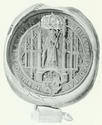 The University of Glasgow was founded by Pope Nicholas V on 7 January 1451. Although this was part of a European wide phenomenon at the time, the inspiration for its foundation came from the Bishop of Glasgow, William Turnbull (d 1484). He believed that the new college would provide an educated clergy for the western parts of Scotland as St Andrews (founded in 1413) did for the east.
The University of Glasgow was founded by Pope Nicholas V on 7 January 1451. Although this was part of a European wide phenomenon at the time, the inspiration for its foundation came from the Bishop of Glasgow, William Turnbull (d 1484). He believed that the new college would provide an educated clergy for the western parts of Scotland as St Andrews (founded in 1413) did for the east.
 The first lectures were given in the Dominican priory of the Black Friars and in the Cathedral. In 1460 a large building to the north of the priory was rented from James, Lord Hamilton (d 1479), and this site was to become the University’s home for the next four hundred years. The papal bull (deed) provided for teaching in all faculties but most students studied Arts and only a few sought higher degrees in theology or canon and civil law.
The first lectures were given in the Dominican priory of the Black Friars and in the Cathedral. In 1460 a large building to the north of the priory was rented from James, Lord Hamilton (d 1479), and this site was to become the University’s home for the next four hundred years. The papal bull (deed) provided for teaching in all faculties but most students studied Arts and only a few sought higher degrees in theology or canon and civil law.
 The principal teachers were known as regents and were expected to teach a variety of subjects. Some of the early regents were notable men, in particular John Major (1469-1550), who wrote A History of Greater Britain, published in 1521. Throughout its first century, the University remained closely linked to the Cathedral with most of its officers holding senior appointments in the diocese. At the Reformation in 1560, Archbishop James Beaton (1517-1603) fled from Glasgow to Paris, taking with him the mace and many of the University’s archives. In the ensuing confusion student numbers fell and for a few years there was only one teacher.
The principal teachers were known as regents and were expected to teach a variety of subjects. Some of the early regents were notable men, in particular John Major (1469-1550), who wrote A History of Greater Britain, published in 1521. Throughout its first century, the University remained closely linked to the Cathedral with most of its officers holding senior appointments in the diocese. At the Reformation in 1560, Archbishop James Beaton (1517-1603) fled from Glasgow to Paris, taking with him the mace and many of the University’s archives. In the ensuing confusion student numbers fell and for a few years there was only one teacher.